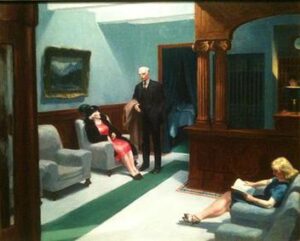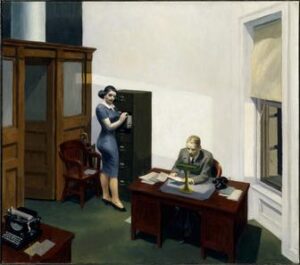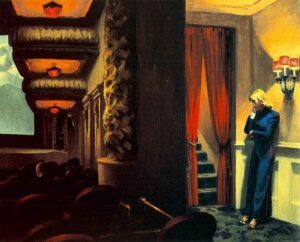
I think we now have a certain advantage of “time” in respect to our viewing of Edward Hopper’s work. It is how he came into his “own” that I wish to discuss. I am taken by the life of Hopper’s “own”, a “resplendent” throughout his life’s work.
Hopper is usually discussed for his take on the lonesome American city or land/seascapes, his singular objects of contemplation. His seemingly, pointlessly, “wondering people” as lonely human beings like inserted characters into still, introspective dramas. Or a dullness in his stretched paint light as a dappled sun, often stark midday or late afternoon or his sense of impending dusk. His landscapes often present themselves as a quiet churning presence and a “suspension of moment”, as if something will happen, the suggestion of full “filament” of living but not quite there yet.
Apart from the pop cultural approach to Hopper as an illustrator of his times, we need to understand what he actually said about himself in respect to art and living. Hopper’s most systematic declaration of his philosophy as an artist was given in a handwritten note, entitled “Statement”, submitted in 1953 to the journal, Reality:
“Great art is the outward expression of an inner life in the artist, and this inner life will result in his personal vision of the world. No amount of skillful invention can replace the essential element of imagination. One of the weaknesses of much abstract painting is the attempt to substitute the inventions of the human intellect for a private imaginative conception. The inner life of a human being is a vast and varied realm and does not concern itself alone with stimulating arrangements of color, form and design. The term life used in art is something not to be held in contempt, for it implies all of existence and the province of art is to react to it and not to shun it. Painting will have to deal more fully and less obliquely with life and nature’s phenomena before it can again become great…”

Though Hopper claimed that he didn’t consciously embed psychological meaning in his paintings, he was deeply interested in Freud and the power of the subconscious mind. He wrote in 1939, “So much of every art is an expression of the subconscious that it seems to me most of all the important qualities are put there unconsciously, and little of importance by the conscious intellect.”
The quiet consciousness of this artist is powerful in an extremely refined manner. Hopper did not wish to be associated with any school, although his early training was with Robert Henri, who is associated with the Hudson Valley and Ashcan school. He vehemently cast off any notion of being called an illustrator, even if he had made a living as a young man doing exactly that. Hopper’s work successfully never becomes “bland pretty” or sentimental or decorative or for that matter un-nostalgic, despite many attempts to interpret his images as a pop theme. No, Hopper has dodged all the populous bullets and has remained an American iconic artist of the highest degree. What do we see in Edward Hopper today?
To me, there is a pondering ill-resolution in Hopper’s work that is both daunting and fierce, but in a very still and quiet way. Hopper’s work has the irreducible touch of humility that is so secret it flits in and out of his canvas like a shiver to your soul. This is not a comfortable feeling, but it is undeniable and difficult to reckon yet it is pervasive in all his work, whether of people or nature or architecture or idea. This is a humane-alienation. He achieves this again and again to the extent his work is bewitching and strange and oh, so familiar. This is never an “effect” but substance and a driven vision. We cling to the beauty and truth and eschew it simultaneously. This is the restless unfinished worry of our American life, a hurry and ponder, a glimpse but not a vision, a revealed secret that flies off into the wind. This is hard to grasp about Hopper, hence his genius that befuddles us – he is so plain yet so un-there in terms of eclipsing moments of anxiety. To the extent he was ever conscious of this quality or power of deep beauty remains his mystery to us. His legacy presses forward in time and it is hard to “aesthetically admit”, but his “humility that haunts” is there, nonetheless. This is the shift of modernism from humanism, the track of human scent, taking us we do not not know where.
Look at Early Sunday Morning, at first we may be taken by the eventuality of a sunny morning awakening a street. The painting is very well laid out symmetrically, as the barber pole and the fire hydrant are characters greeting the morning, and then we look above the shops.. are there people about to arrive from sleep and dreams of morning of day coming to what? There is a hint of anxiety of eventuality implied in a very subtle way via the angle of sunlight, the escaping shadows, the drawn window shades, but the sun as a character as much as the barber pole and fire hydrant waking them and to what? This picture implies a process of consciousness awakening behind the beautiful green, red and brown city block that will unfold into day, but we are right here at that moment unfolding before us, frozen or held still with humility— for the picture is about people, whether we know it or not. And what do we decide?

In many ways this picture is about a certain innocence of our America gone by. But there is an implied foreboding as well as there is with most of Hopper’s work. His use of brush, paint, light, composition, his unconsciousness employed, his sense of territory and his eye, his wife Jo, the fact he never left New York but travelled to Paris and around the country to paint, all these factors combine in unexplainable ways that haunt this quiet man’s work. We are lucky he harnessed them to his “own”, but do we pay attention to what he implies?
Al Jirikowic
Volume 34 no.2 November/December 2019 pp 12-13

Edward Hopper is the epitome of American culture; looking at his paintings the scenes could only be in America. His style is somewhat reminiscent of Andrew Wyeth’s watercolors, they both have that same dreamlike distance from the images that they painted.
Rob,
Are you comparing Hopper to Wyeth? There is no possible paragon between the two artists, unbelievable that you should even try to make one! Where are your roots man?
Hopper and Wyeth were both well crafted traditional painters. One was original the other was banal.